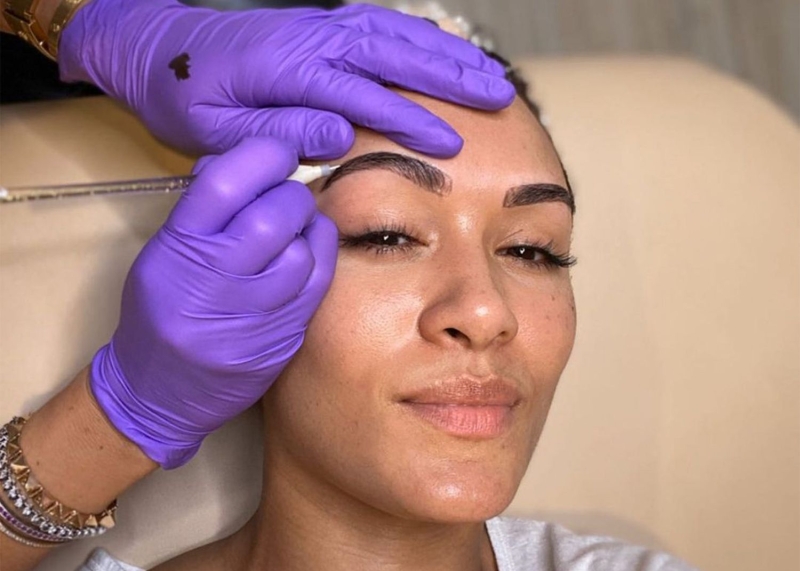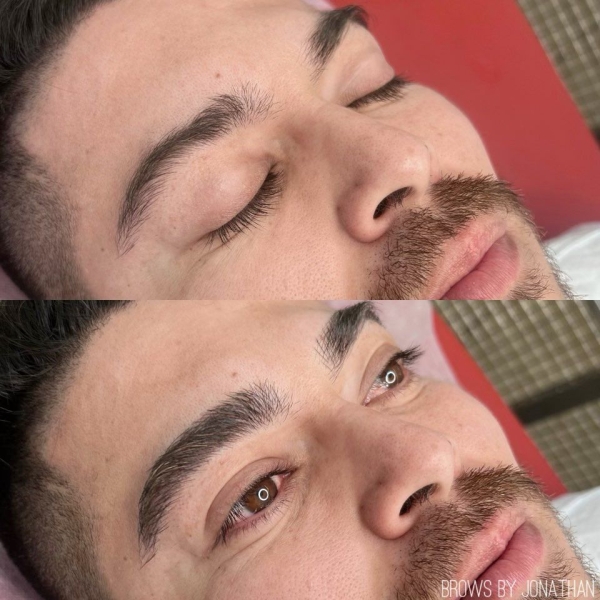Contents

Imagine waking up every morning to perfect-looking brows with no makeup required. Thanks to the art of permanent makeup, you can.
“Makeup pros know well-groomed brows helps frame the face and give you a more polished and rested look,” says Piret Aava, a brow specialist and CEO of Eyebrow Doctor. “With today’s sophisticated application tools, safe pigments, and tiny needles, permanent makeup — including microblading and powder brows — make it possible to have great-looking, natural arches 24/7.”
Ahead, experts explain the differences between powder brows and microblading.
What is Microblading?

Microblading is ideal for anyone with sparse, uneven, or thinning eyebrows. A handheld tool equipped with tiny needles is used to create small, hair-like strokes on the superficial layers of the skin while depositing pigment. “The strokes end up looking like actual eyebrow hairs,” says Alexa Nika, a master permanent-makeup artist and owner of MOKO Beauty Studio. Total appointment time is between one and a half and two hours, with a follow-up visit four to six weeks later to make any necessary touchups. “Over time, the pigment will fade,” notes Nika. “A refresh every 12 to 18 months will be required to maintain the desired color and shape of the eyebrows.”
“Microblading is not recommended for women who are pregnant, taking Accutane, allergic to metal or dyes, or anyone suffering from conditions where the skin barrier is compromised such as with eczema, rosacea and psoriasis,” says board-certified dermatologist Joshua Zeichner, MD. “You’ll also want to avoid this treatment if you’re susceptible to keloid scars or have oily skin, as oil can interfere with pigment retention and the healing process.”
What Are Powder Brows?

Powder brows are perfect for anyone who desires a filled-in brow look similar to what you’d get with makeup. “During this technique, a tattoo pen with a fine needle embeds tiny dots of pigment into the superficial layers of the skin, resulting in a soft, powdered brow,” says Clara Medina, a master permanent-makeup artist at the Modern Beauty Studio Academy. In some cases, clients request an ombre effect, where the brows appear lighter by the nose and darker towards the tail. The process takes two to three hours, and sometimes an additional session is required between four and eight weeks later. “Two to three years down the road, clients will need to come in for a color boost,” adds Medina.
“Those who shouldn’t attempt powder brows fall into the same category as those who shouldn’t attempt microblading — the only difference being, powder brows are suitable for all skin types,” says Dr. Zeichner, who is also an associate professor of dermatology at Mount Sinai Hospital in New York City.
Prepping for Permanent Brow Makeup
For both microblading and powder brows, you’ll need to stop shaping, waxing, threading, and tinting your brows about four weeks prior so that your technician gets a better sense of your natural brow shape and fill. You’ll also need to skip lasers, chemical peels, microdermabrasion and facials, which can thin the upper layer of the skin and result in improper placement of the pigment and poor color retention. A week before treatment, avoid products containing retinols or exfoliating acids that can sensitize the skin. Twenty-four hours prior, stop drinking alcohol and caffeine, which can thin the blood and increase bleeding during the procedure. Sunbathing is also a no-no. “Peeling, sunburned skin will take the pigment with it,” cautions Dr. Zeichner.
What Happens During Powder Brow and Microblading?
The Initial Consult
On the day of treatment, the skin is cleansed and disinfected before it’s numbed with a topical anesthetic to minimize discomfort. “At this time, your technician will determine your appropriate brow color and desired look based on your natural brows before using a special pencil to map out the shape,” notes Melissa Byrne, a brow artist and owner of ARCHES.
The Pain Factor
“Pain is always subjective, but the majority of my clients feel next to nothing during these two procedures — many even fall asleep,” says Nika. “The sensation has been described as someone ‘scratching at the skin’ [or] to how it feels when getting brows threaded.” The good news is that any sensation seems to diminish as the procedure progresses. “Be sure to communicate any discomfort to your technician during the procedure,” says Nika.
Initial Results
For the first few days after either procedure, the brows may appear darker and bolder due to some swelling and pigment oxidation. “However, as the skin heals and the pigment settles in, the color will lighten to achieve a more natural-looking result,” says Byrne. “Oftentimes, at this stage, clients get nervous thinking something has gone wrong. But it’s all part of the healing process as the skin absorbs the pigment. After the scabbing, most of the color will return, albeit a bit lighter.” The pigment loss is usually a little greater with powder brows. “Four to six weeks after the procedure, you’ll see 30 to 40 percent of color fading, with the result being a softer and more natural-looking brow,” Medina notes.
The Cost
The cost for microblading and powder brows is dependent on the technician’s experience, product quality, and location. “Anticipate fees in the range of $300 to $700 for microblading and $300 to $1,200 for powder brows, with touchups for both starting at $100 and up,” says Medina.
Aftercare Tips

It's common to experience some mild redness and swelling immediately after either procedure. “The treated area may feel tender to the touch, similar to a sunburn, but this should subside within a few hours,” says Aava. “A cold compress can help alleviate discomfort while reducing swelling.” Microblading recipients can expect individual scabs on each stroke, while powder-brow treatments result in one big scab. “Itching can be an issue, but it’s important not to pick at the scabs or risk interfering with the healing process,” says Dr. Zeichner. “As the days progress, you may notice some dry and flaky skin, which is a normal. Try not to touch the skin at this time.”
To ensure continued success, stay out of the sun for two weeks afterwards and apply a daily semi-occlusive barrier ointment like Aquaphor to keep the area moisturized and promote healing. “Refrain from getting the area wet and avoid activities that can cause excessive sweating, all of which could affect pigment retention,” advises Dr. Zeichner, who also suggests keeping the brows free of makeup and skincare products until the skin fully heals. Also steer clear of retinoids and exfoliators, which can trigger shedding of the pigment.
Safety and Risks
The same care practices apply to both microblading and powder brows to prevent infection. “Your technician needs to follow strict hygiene protocols to ensure a safe and sanitary procedure,” notes Dr. Zeichner. “Ask them about their sterilization methods, use of disposable tools and supplies, and adherence to local health and safety regulations.”
It’s important to monitor for signs of infection such as increased redness, swelling, pain, or pus drainage from the treated area. If this occurs, you’ll need to see a dermatologist for a topical antibiotic. Dr. Zeichner strongly recommends a patch test for both procedures to identify any allergies, as well as possible scarring or keloids issues. “This skin check is easily performed by gently scratching a small area of the skin and applying a dot of pigment to see if any reaction occurs within the first 48 hours,” he says.
Finding a Qualified Technician
It’s important your technician is properly trained, certified, and licensed to perform in your area. Research their accreditation through the American Academy of Micropigmentation, then look at their reviews and before-and-after photos to get a sense of their reputation and the quality of their work. “You want to find someone who has experience with your skin tone and brow shape,” says Nika. “Schedule a pre-consultation to discuss your goals, preferences, and any concerns you may have about the procedure, and when meeting, pay close attention to factors such as professionalism, communication, and cleanliness.”
How to Choose Which Is Right for You
The main difference between microblading and powder brows lies in the technique: microblading uses a blade to cut into the skin, while needles are used for powder brows. There's also the end look: microblading results in hair-like strokes, mimicking the appearance of natural eyebrows, while powder brows create a filled-in look, similar to eyebrow powder or makeup. There are some differences in their longevity, but the prep, aftercare, risks, and costs are mostly the same.
Frequently Asked Questions
- Should I bring an inspo photo?
“Yes, but your brow look will be based on what’s most aesthetically pleasing to your personal situation, taking into consideration your face shape, features and skin tone,” notes Medina.
- Can I wear makeup afterwards?
“Not until your brows have gone through the scabbing process,” Byrne cautions. “Makeup can affect the pigment retention, slow the healing process and potentially cause an infection.”
- Can I combine microblading and powder-brow treatments?
Yes. “This dual technique is often referred to as hybrid, combo, or microshading, and is great for someone who wants to create the illusion of more hair while also having it appear as if their brows have been filled in with makeup,” says Aava. “Typically, microblading takes place in the thicker area closest to the nose and powder brows on the tail section.”
- Are the procedures reversible?
Reversal is an option if you’re not happy with the results. “There are lasers that can break the pigment into smaller particles, which get absorbed into the body. But they can be costly, painful, and require after care and multiple sessions,” says Nika. There’s also a treatment where a saline solution is introduced to dry out the pigment. “The saline basically lifts the pigment up and out of the skin,” explains Nika. “You can do an emergency procedure within the first forty-eight hours but it’s much harder to get a complete removal once time has passed and the skin has healed over the pigment.”

